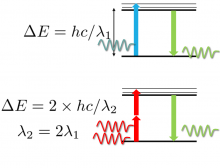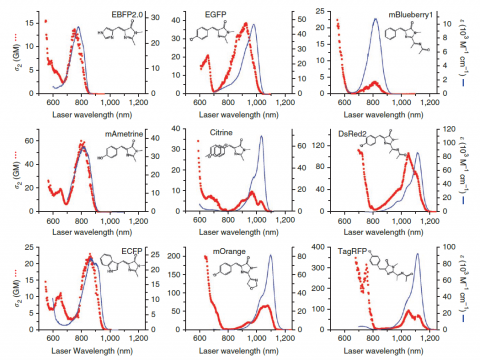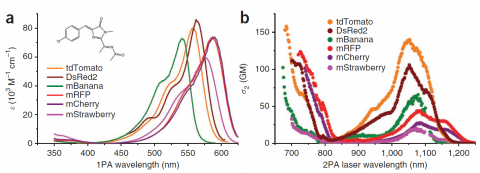
Introduction
Two-photon excitation microscopy (TPEM) utilises the two-photon absorption process to achieve much deeper imaging than laser scanning confocal microscopy (LSCM). When densely packed, in time and space, two photons can be absorbed in one event by a fluorophore, causing it to fluoresce. Due to the requirements for two-photon absorption to occur a particular type of laser source must be used: one with very short intense pulses of light. It is also through this requirement that TPEM produces inherently sectioned images - only the volume within the focal spot of the laser fluoresces i.e. there is no 'out-of-focus' flourescent light. Compare this with LSCM in which for each spot measured a volume of excitation occurs with a pinhole being used to mechanically reject the out-of-focus components.
So the 2-photon absorption gives natural sectioning with no pinhole or descanning required; where does the deeper imaging come from? Using longer wavelengths allows deeper penetration of samples as depth is very much affected by scattering of the light. The scattering experienced in biological tissue is inversely related to the wavelength raised to a power > 1. Longer wavelengths mean substantially less scattering. As the photons required must be approximately half the energy each of that required for excitation to occur the wavelength is approximately double ( as energy is inversely proportional to wavelength).
In short: two-photon excitation occurs at roughly twice the wavelength (half the energy) of the single photon excitation, longer wavelengths mean less scattering and the probability of photons adding together means this really only happens at the focus of a high power pulsed near infrared laser.
Things to know before using a 2-photon microscope


One of the most striking differences between one and two photon excitation (other than depth of imaging) is the difference in their excitation spectra for the same fluorochrome. As such it is important to assess the cross-section of the combinations of fluorescent markers you wish to use in your samples with the excitation laser wavelength range available. Various cross-section profiles can be seen above (figures shown are from [1]).
CAIC's 2-photon microscope
Importantly, our microscope is an upright microscope. Please make sure your sample is mounted such that it can be imaged with an upright microscope with a 2mm working distance water immersion lens. Our microscope is also equipped with a Dual line Spectra-Physics Insight DeepSee. The laser has a tunable line from 680-1300nm with more than 1W average power across the range and a fixed laser line at 1040nm (600mW). Using these two laser lines in combination we can efficiently, and simultaneously, excite a wide variety of fluorescent probe combinations.
References
[1] Two-photon absorption properties of fluorescent proteins. Mikhail Drobizhev, Nikolay S Makarov, Shane E Tillo, Thomas E Hughes & Aleksander Rebane. Nature Methods 8, 393-399 (2011).
[2] Two-photon fluorescence absorption and emission spectra of dyes relevant for cell imaging. F Bestvater et al. Journal of Microscopy 208, 108-115 (2002)
